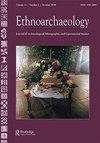The Lives of Stone Tools: Crafting the Status, Skill, and Identity of Flintknappers
IF 1.3
0 ARCHAEOLOGY
引用次数: 1
Abstract
Kathryn Weedman Arthur has produced a fantastic and delightful book. The Lives of Stone Tools is an ethnographic account of stone tool production and use in late twentieth century Ethiopia. It is a valuable cautionary tale on all of the potential cultural and symbolic meaning prehistoric stone tools may have possessed and manifested, which would be invisible to archaeologists if indeed this meaning were reality for prehistoric people. Of course, we as archaeologists will never definitively know, and there is always a danger of imposing meaning in cases where it did not exist in antiquity. But, at least in this reviewer’s eyes, Arthur’s take home lesson is that we as archaeologists must acknowledge the possibility, perhaps likelihood, of lost meaning. In so doing, we will question, or at least reconsider, the narratives and biases present in the discipline, some of which must be abandoned. Such questioning and reconsideration not only increases human sensitivity and inclusiveness, but also is, in fact, a founding tenet of a scientific approach. In the end, Arthur’s volume reminds us that nothing in science is truly sacred except for the scientific method itself. This method, if faithfully applied, must acknowledge what is, and is not, testable, and if the latter, should not be automatically disregarded, because ideas and theories that are not testable are not necessarily without value. Beyond its relevance to archaeology, Lives is a rich illustration of people, their technology, and their livelihoods. Beautifully and clearly written, Arthur weaves together a tale of deep human-tool relationships. This reviewer was enthralled with just how intense the Gamo’s indigenous ontology was embedded in their stone tools, from a tool’s birth, maturity, and death. Yet this book is as much about the people as it is about their technology, and learning about the status of the Gamo in relation to the larger society in which they live and interact was fascinating. Although all black and white, the images peppered throughout the book are informative and help to paint a vivid picture of the Gamo people. Additionally, several aspects of the book – ranging from discussions of artifact context, form, and use; to raw material procurement; to resharpening; and finally to discard patterns – can serve as models against which the archaeological record can be compared. The Lives of Stone Tools should be required reading for virtually everyone in the archaeological discipline. It is a challenging, rewarding read that has implications for how archaeologists study any kind of material culture. Specifically, it reminds us that we as archaeologists “must consider Indigenous theories of being as equals and as alternatives to Western theories of material culture” (page 234), and that, vitally, these two theory sets are not mutually exclusive.石器时代:塑造燧石手的地位、技能和身份
凯瑟琳·魏德曼·亚瑟创作了一本奇妙而令人愉快的书。《石器的生活》是一本关于20世纪后期埃塞俄比亚石器生产和使用的民族志。这是一个有价值的警示故事,关于史前石器可能拥有和表现的所有潜在的文化和象征意义,如果这种意义对史前人类来说确实是现实的话,考古学家可能看不到。当然,作为考古学家,我们永远无法确切地知道,而且总是有一种危险,那就是在古代不存在意义的情况下强加意义。但是,至少在这个评论家的眼中,亚瑟的教训是,作为考古学家,我们必须承认失去意义的可能性,也许是可能性。在这样做的过程中,我们将质疑,或者至少重新考虑,在这个学科中存在的叙述和偏见,其中一些必须被抛弃。这种质疑和反思不仅增加了人类的敏感性和包容性,而且实际上也是科学方法的基本原则。最后,亚瑟的书提醒我们,除了科学方法本身,科学中没有什么是真正神圣的。如果忠实地应用这种方法,就必须承认什么是可测试的,什么是不可测试的,如果是后者,就不应该被自动忽视,因为不可测试的思想和理论不一定没有价值。除了与考古学的相关性之外,《生活》还丰富地展示了人类、他们的技术和他们的生计。亚瑟写得优美而清晰,编织了一个关于人类与工具之间深刻关系的故事。从工具的诞生、成熟到死亡,加莫人的土著本体深深嵌入了他们的石制工具中,这让笔者着迷。然而,这本书既是关于人类的,也是关于他们的技术的,了解加莫人在他们生活和互动的更大社会中的地位是令人着迷的。虽然全是黑白的,但书中穿插的图像信息丰富,有助于描绘出一幅生动的加莫人的画面。此外,本书的几个方面——从工件上下文、形式和使用的讨论;对原材料进行采购;重磨;最后,放弃模式——可以作为考古记录的比较模型。《石器时代》应该是几乎所有考古学研究者的必读书目。这是一本具有挑战性、有益的读物,对考古学家如何研究任何一种物质文化都有启示。具体地说,它提醒我们,作为考古学家,我们“必须把本土的存在理论视为与西方物质文化理论平等的替代品”(第234页),而且,重要的是,这两套理论并不相互排斥。
本文章由计算机程序翻译,如有差异,请以英文原文为准。
求助全文
约1分钟内获得全文
求助全文
来源期刊

Ethnoarchaeology
ARCHAEOLOGY-
CiteScore
1.60
自引率
0.00%
发文量
10
期刊介绍:
Ethnoarchaeology, a cross-cultural peer-reviewed journal, focuses on the present position, impact of, and future prospects of ethnoarchaeological and experimental studies approaches to anthropological research. The primary goal of this journal is to provide practitioners with an intellectual platform to showcase and appraise current research and theoretical and methodological directions for the 21st century. Although there has been an exponential increase in ethnoarchaeological and experimental research in the past thirty years, there is little that unifies or defines our subdiscipline. Ethnoarchaeology addresses this need, exploring what distinguishes ethnoarchaeological and experimental approaches, what methods connect practitioners, and what unique suite of research attributes we contribute to the better understanding of the human condition. In addition to research articles, the journal publishes book and other media reviews, periodic theme issues, and position statements by noted scholars.
 求助内容:
求助内容: 应助结果提醒方式:
应助结果提醒方式:


